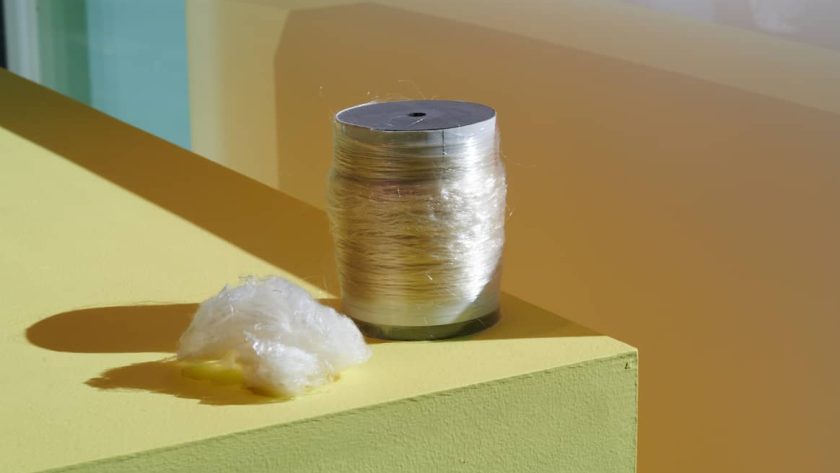Nicolaj Reffstrup, the CEO of Danish label Ganni, is betting on the potential of innovative materials to clean up the fashion industry, and believes collaboration between brands and start-ups will play a pivotal role in achieving that.
At the Global Fashion Summit in late June, Ganni showcased a “carbon-negative cellulosic textile”, which is said to be made directly from carbon emissions through “a fully enzymatic process”.
The material – revealed on stage by Reffstrup in the form of a humble pulp and yarn – was developed by Rubi, a California-based biotech start-up which has received backing from fashion powerhouses H&M and Patagonia, among others.
Speaking to FashionUnited, Reffstrup described how Rubi’s technology mimics the way trees grow: The company uses biochemical processes powered by enzymes at an industrial scale to “eat” carbon emissions and from them make “carbon-derived, resource-neutral” textiles.
‘Game-changing’ technology
Ganni will be the first fashion brand to trial the fabrics made with Rubi’s patent-pending technology through a blend composition of 20 percent Rubi cellulose yarn and standard industry cellulose.
There’s a long way to go before the technology is scaled up, but Rubi could be “game-changing for us and for the wider industry”, Reffstrup told FashionUnited. “This could be a core part of our at-scale material consumption, especially because this is not a fermentation process, so it doesn’t require a lot of energy – and no water. If they truly manage to scale it, then you have a product that will definitely hit price parity with conventional fabrics.”
The next step, Reffstrup said, would be for Ganni to install carbon sequestration equipment along its supply chain. “We would literally pipe the fumes from our production and feed them into these enzymes to produce the yarns on site. That’s the goal. It’s beautiful. It’s almost too good to be true.”
And Rubi isn’t the only innovative start-up Ganni is working with. The Copenhagen-based label is currently supporting over two dozen companies through its research and development arm, called Fabrics of the Future, which it launched back in 2019.
“It’s basically like a university,” Reffstrup explained. “We have a lot of students that are trying to graduate – and some do, while others don’t.” Ganni previously announced a target to reduce its carbon footprint by 50 percent between 2021 and 2025 in absolute figures. Innovative materials will play a “huge strategic role” in that, Reffstrup said.
Focus on material innovations
Ganni is currently backing 27 innovations through Fabrics of the Future and has the capacity for a total of around 30. The target is for six materials to “graduate” each year, leading to their implementation in limited production before further scaling up.
One recent success story from the programme was Polybion, a start-up creating premium biomaterials from fruit waste. In July, Ganni and Polybion showcased a bio-leather blazer made entirely from Celium, a material derived from bacterial cellulose. Reffstrup described the garment as having a “super funky looking, yellow, marble-like surface”.
On the topic of aesthetics, Ganni also recently worked with a start-up creating a product with a shearling look. While Reffstrup noted the impressive appearance, he also acknowledged that therein lies an essential question when it comes to innovative materials: Should they merely mimic existing options, or should they pave their own unique path? “You don’t necessarily want to present vegetarians with a soy-based T-bone steak, right?” he pondered.
Beyond aesthetics, many other obstacles arise when scaling up and introducing innovative new materials to the industry, not the least being pricing. “That is one of the biggest problems we have as a brand at our price point, because we are so committed to the agenda of finding these innovative materials that we’re constantly at risk of pricing ourselves out of our market.”
Challenges ahead
The brand’s Fabrics of the Future programme in general is also not cheap to run. In addition to direct costs, the company must allocate resources for teams, certifications, and consulting advice.
It has also been forced to turn down a lot of commercially viable conventional fabrics. “We’ve had bestsellers that are made in conventional materials and collaboration opportunities that we’ve had to phase out or turn down because they don’t live up to our standards,” Reffstrup said. “So there’s also the indirect cost that comes with lost opportunities. I wouldn’t call it a struggle because it’s an exciting challenge, but it hits you every day across the board. It’s a sacrifice.”
Aside from its focus on innovative materials, Ganni has also launched a number of other sustainable initiatives in recent years. The company previously set itself a target for 5 percent of its revenue to come from circular business models by 2025.
“By now we know that the only circular business model that really works for us is in-store re-commerce,” Reffstrup said. In fact, it’s been so successful that the company is now prioritising its roll-out across the business. “We haven’t quite figured out online re-commerce but we will make it happen. Rental and subscription don’t work for us,” he added, citing the brand’s price point.
Reffstrup also emphasised the importance of regulative and legislative efforts in driving real change in the industry. “We embrace all of them. We think it will just level the playing field and nudge the industry in the right direction. We’ve always kind of wanted that,” Reffstrup said.
In 2016, Ganni started levying its own carbon tax and offsetting its emissions, before shifting to insetting emissions last year. Reffstrup noted the decision to self tax came because “no politicians ever had the guts to do it”. He welcomed new progress being made in the legislative space, but added: “Our biggest worry is that it’s not coming quick enough.”
Concluding the conversation back on the topic of sustainable materials, Reffstrup maintained an optimistic but realistic outlook on developments in the alternative material space. It will take a lot of trial and error, but will pay off in the end, he figures.
“Take vegan leather, for example. Sure, there might be a PU component in it, and that’s not perfect, but it is constantly evolving. Calf leather has been around for thousands of years and you cannot improve on it,” he said.
“But you can improve vegan leather because it’s a controlled environment where you can optimise the stuff you put in it, and then you know what you’re getting out of it. So ask me again 10 years from now, will we have superior materials? I don’t doubt that for a second.”



